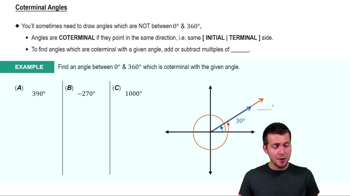Table of contents
- 0. Review of College Algebra4h 43m
- 1. Measuring Angles39m
- 2. Trigonometric Functions on Right Triangles2h 5m
- 3. Unit Circle1h 19m
- 4. Graphing Trigonometric Functions1h 19m
- 5. Inverse Trigonometric Functions and Basic Trigonometric Equations1h 41m
- 6. Trigonometric Identities and More Equations2h 34m
- 7. Non-Right Triangles1h 38m
- 8. Vectors2h 25m
- 9. Polar Equations2h 5m
- 10. Parametric Equations1h 6m
- 11. Graphing Complex Numbers1h 7m
9. Polar Equations
Polar Coordinate System
Problem 29
Textbook Question
In Exercises 27–32, select the representations that do not change the location of the given point. (2, − 3π/4) (2, − 7π/4)
 Verified step by step guidance
Verified step by step guidance1
Step 1: Understand that the given points are in polar coordinates, where the first value is the radius (r) and the second value is the angle (θ).
Step 2: Recognize that polar coordinates can have multiple representations for the same point by adding or subtracting full rotations (2π radians) to the angle.
Step 3: For the point (2, −3π/4), consider adding 2π to the angle to find an equivalent angle: θ = −3π/4 + 2π.
Step 4: For the point (2, −7π/4), similarly, add 2π to the angle to find an equivalent angle: θ = −7π/4 + 2π.
Step 5: Compare the new angles obtained in Steps 3 and 4 to determine if they represent the same location as the original point (2, −3π/4).
Recommended similar problem, with video answer:
 Verified Solution
Verified SolutionThis video solution was recommended by our tutors as helpful for the problem above
Video duration:
0m:0sPlay a video:
Was this helpful?
Key Concepts
Here are the essential concepts you must grasp in order to answer the question correctly.
Polar Coordinates
Polar coordinates represent points in a plane using a distance from the origin and an angle from the positive x-axis. The format is (r, θ), where 'r' is the radial distance and 'θ' is the angle in radians. Understanding polar coordinates is essential for determining how different representations of the same point can be derived through angle adjustments.
Recommended video:

Intro to Polar Coordinates
Angle Coterminality
Two angles are coterminal if they differ by a multiple of 2π radians. This means they point to the same location on the unit circle. Recognizing coterminal angles is crucial for identifying which representations of a point in polar coordinates remain unchanged in terms of their position.
Recommended video:

Coterminal Angles
Unit Circle
The unit circle is a circle with a radius of one centered at the origin of a coordinate plane. It is fundamental in trigonometry for visualizing angles and their corresponding sine and cosine values. Understanding the unit circle helps in determining the coordinates of points represented in polar form and how they relate to different angles.
Recommended video:

Introduction to the Unit Circle

 5:32m
5:32mWatch next
Master Intro to Polar Coordinates with a bite sized video explanation from Callie Rethman
Start learningRelated Videos
Related Practice













